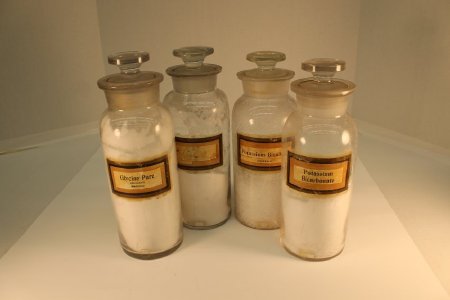Object ID Number:
PH104
Object Name:
Bottles
Type:
Shop Furniture
Manufactured from:
1820
Manufactured to:
1850
Description / History:
In this collection there are four clear, glass cylindrical bottles which stored different chemical components to create medicines in the pharmacy. This collection contains 3 handblown glass bottles with smooth bottoms and 1 machine blown glass bottle. These specific styles of glass would have been produced during the middle 1800s. The bottles also contain paper labels. The labels are bordered with a gold, black, and yellow stripe and contain the name of the chemical substance printed in black. Below is a brief description of each bottle and the original contents which still remain in the bottles today.
Bottle A: Bottle A contains a label reading "Potassium Bisulfate – Crystals" and is still filled approximately halfway with potassium bisulfate. The potassium bisulfate IS a white crystal that also appears to have a very small amount of liquid at the base. Potassium bisulfate is made by treating potassium sulfate with sulfuric acid. If potassium bisulfate is ingested in its purest form it can lead to burning the GI track and if inhaled can irritate the respiratory track, therefore it is not likely that this was used directly for medicinal purposes. There is no real indication of what potassium bisulfate would have been used for, but we can assume it was combined with other chemical compounds to create forms of medicine. Today, potassium bisulfate is used as a food preservative.
Bottle B: Bottle B contains a label however the printed name has completely faded to match the off–white background of the label and a green stamp covering most of the label. With careful observation, one can make out the word Zinc on the label, although there appears to be another word that cannot be made out. The bottle is about a third full with a white powder that has a similar texture to that of flour.
Bottle C: Bottle C contains a label reading "Potassium Bicarbonate" and appears about half full with a white powder. Today, potassium bicarbonate is used to help those with potassium deficiency, however can cause the side effects of diarrhea and vomiting. Most likely in the 1800s, potassium bicarbonate was used just for these exact side effects to try and rid the sick body of the bad bacteria.
Bottle D: Bottle D contains the label "Gylcine Pure (Glycocoll) Medicinal" and is approximately 3/4 full with a thick, white powder. Glycine is a necessary amino acid for the human body and has many purposes in the medical world. Originally, glycine was used to treat leg ulcers and other skin ailments by applying it directly to wound. Glycine has since been used to treat schizophrenia, stroke, and benign prostatic hyperplasia. Today, we are still discovering more benefits of glycine including protecting organs, such as the kidney and liver, from the side effects of drugs after surgery. There is also continuing research to see if there is a relation between glycine and memory improvement and glycine and cancer prevention.
Bottle A: Bottle A contains a label reading "Potassium Bisulfate – Crystals" and is still filled approximately halfway with potassium bisulfate. The potassium bisulfate IS a white crystal that also appears to have a very small amount of liquid at the base. Potassium bisulfate is made by treating potassium sulfate with sulfuric acid. If potassium bisulfate is ingested in its purest form it can lead to burning the GI track and if inhaled can irritate the respiratory track, therefore it is not likely that this was used directly for medicinal purposes. There is no real indication of what potassium bisulfate would have been used for, but we can assume it was combined with other chemical compounds to create forms of medicine. Today, potassium bisulfate is used as a food preservative.
Bottle B: Bottle B contains a label however the printed name has completely faded to match the off–white background of the label and a green stamp covering most of the label. With careful observation, one can make out the word Zinc on the label, although there appears to be another word that cannot be made out. The bottle is about a third full with a white powder that has a similar texture to that of flour.
Bottle C: Bottle C contains a label reading "Potassium Bicarbonate" and appears about half full with a white powder. Today, potassium bicarbonate is used to help those with potassium deficiency, however can cause the side effects of diarrhea and vomiting. Most likely in the 1800s, potassium bicarbonate was used just for these exact side effects to try and rid the sick body of the bad bacteria.
Bottle D: Bottle D contains the label "Gylcine Pure (Glycocoll) Medicinal" and is approximately 3/4 full with a thick, white powder. Glycine is a necessary amino acid for the human body and has many purposes in the medical world. Originally, glycine was used to treat leg ulcers and other skin ailments by applying it directly to wound. Glycine has since been used to treat schizophrenia, stroke, and benign prostatic hyperplasia. Today, we are still discovering more benefits of glycine including protecting organs, such as the kidney and liver, from the side effects of drugs after surgery. There is also continuing research to see if there is a relation between glycine and memory improvement and glycine and cancer prevention.
